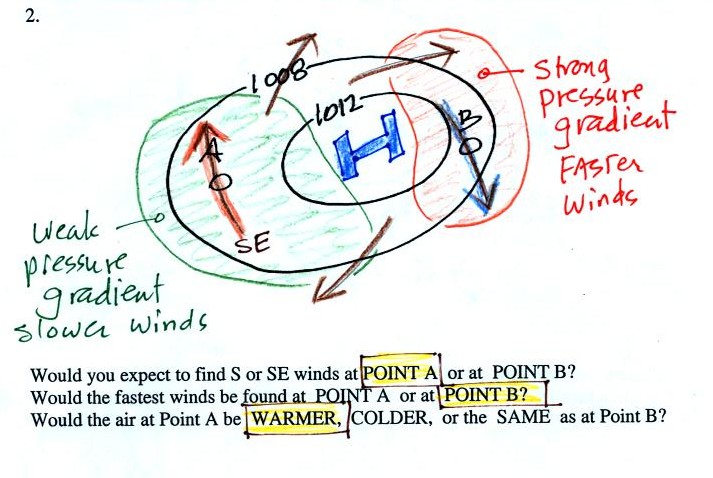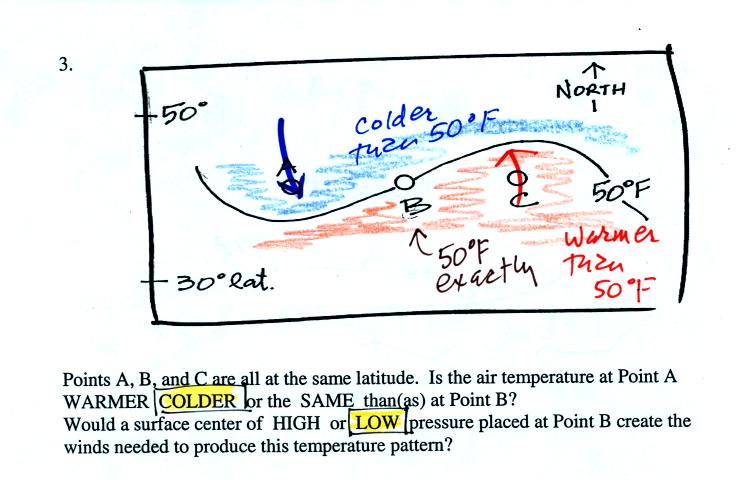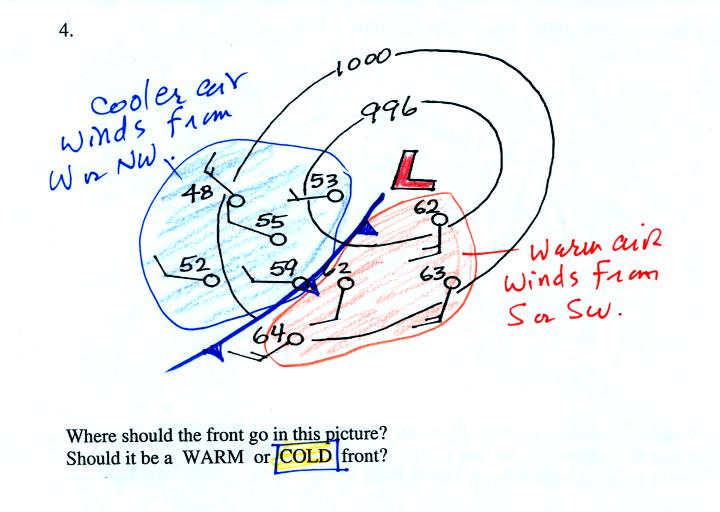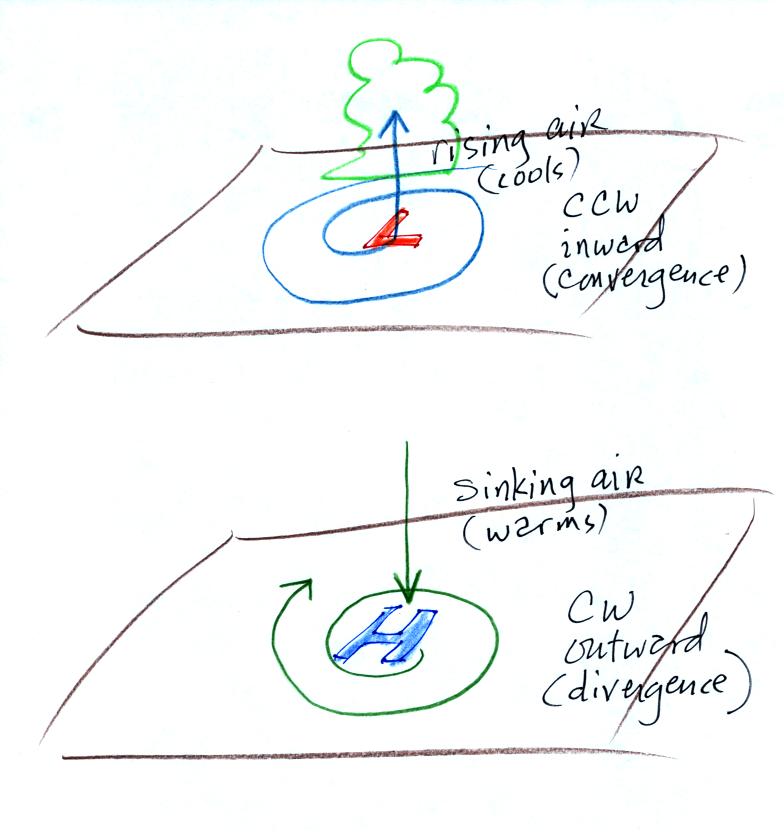
Winds spin clockwise
and spiral outward, diverge, from high pressure. Sinking air in
the center of the high replaces the outward moving air. Sinking
air warms and prevents clouds from forming.
Now some new material.
The pressure pattern will also tell you something about where you might expect to find fast or slow winds. In this case we look for regions where the isobars are either closely spaced together or widely spaced. (I'm using some more carefully drawn pictures from the Spring 2008 class)

Closely spaced contours means pressure is changing
rapidly
with
distance. This is known as a strong pressure gradient and
produces fast winds. It is analogous to a steep slope on a
hillside. If you trip, you will tumble rapidly down a steep
hillside, more slowly down a gradual slope.
The winds around a high pressure center are shown above using both the station model notation and arrows. The winds are spinning clockwise and spiralling inward slightly.
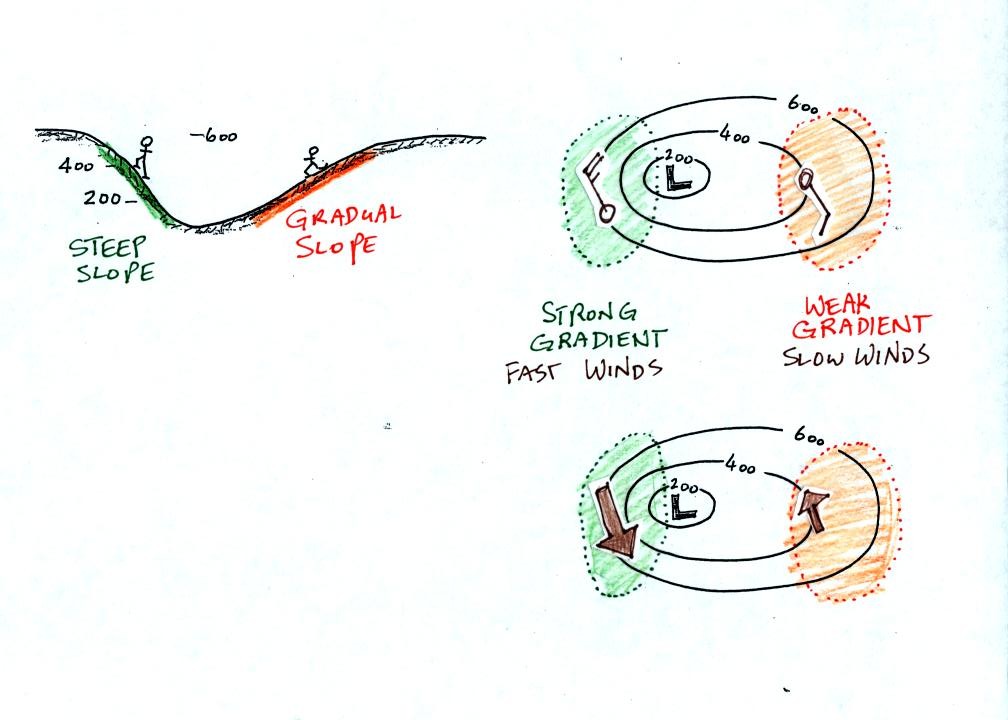
Winds spin counterclockwise and spiral inward around
low
pressure
centers.
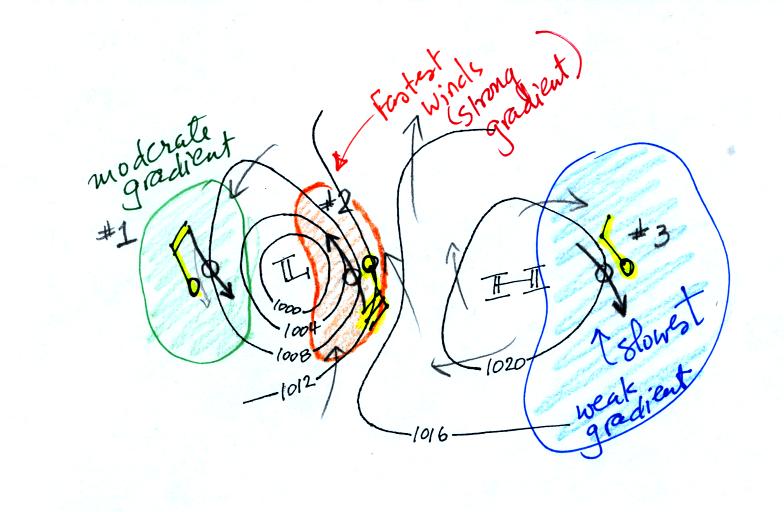
This is the figure from the bottom of p. 40c. The fastest
winds (blowing from the SE) are found in the center of the
picture. The slowest winds are found on the right side of the
figure where the contours are far apart. Note the southerly winds
in the middel of the picture would probably be warmer (because they are
coming from the south) than the NW winds at the right and left sides of
the pictures.
The pressure pattern determines the wind direction and wind speed. Once the winds start to blow they can affect and change the temperature pattern. The figure below shows the temperature pattern you would expect to see if the wind wasn't blowing at all or if the wind was blowing straight from west to east. The bands of different temperature are aligned parallel to the lines of latitude. Temperature changes from south to north but not from west to east.
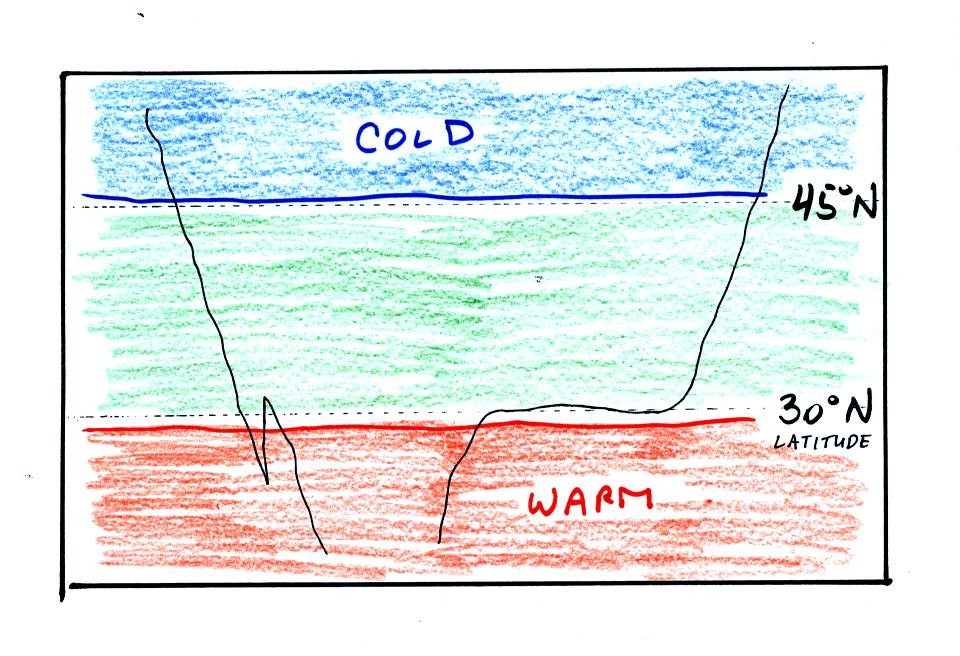
This isn't a very interesting
picture. It gets a
little
more interesting if you put centers of high or low pressure in the
middle.

The clockwise spinning winds
move warm air to
the north on
the western
side of the High. Cold air moves toward the south on the eastern
side of the High. The diverging winds also move the warm and cold
air away from the center of the High.
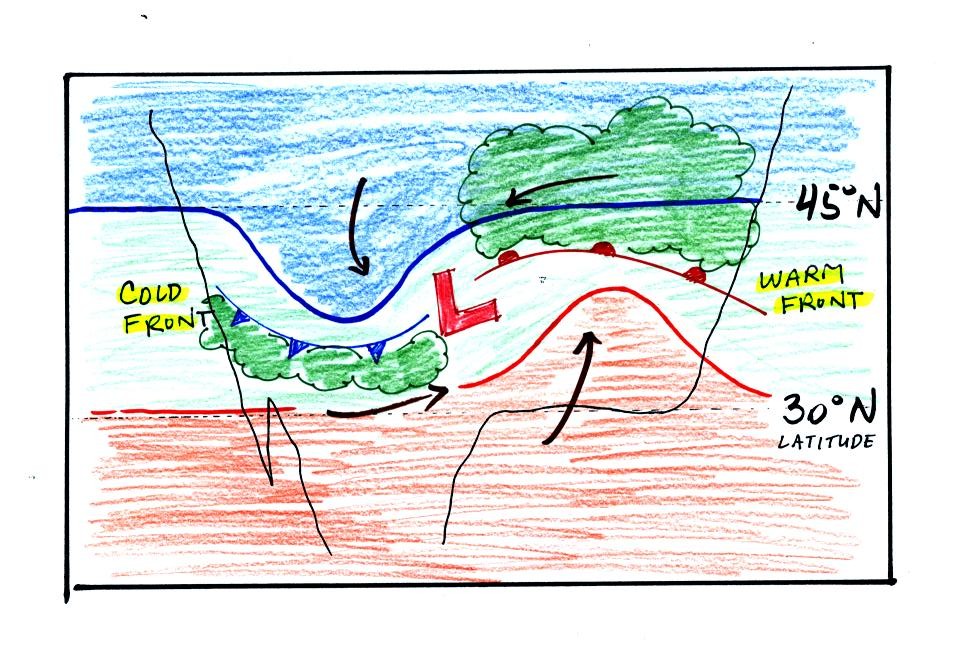
Counterclockwise winds move cold air toward the south
on the
west side
of the Low. Warm air advances toward the north on the eastern
side of the low.
The converging winds in the case of low pressure will move the air masses of different temperature in toward the center of low pressure and cause them to collide with each other. The boundaries between these colliding air masses are called fronts. Fronts are a second way of causing rising air motions (rising air expands and cools, if the air is moist clouds can form)
Cold air is moving from north toward the south on the western side of the low. The leading edge of the advancing cold air mass is a cold front. Cold fronts are drawn in blue on weather maps. The small triangular symbols on the side of the front identify it as a cold front and show what direction it is moving. The fronts are like spokes on a wheel. The "spokes" will spin counterclockwise around the low pressure center (the axle).
A warm front (drawn in red with half circle symbols) is shown on the right hand side of the map at the advancing edge of warm air. It is also rotating counterclockwise around the Low.
Clouds can form along fronts (often in a fairly narrow band along a cold front and over a larger area ahead of a warm front). We need to look at the crossectional structure of warm and cold fronts to understand better why this is the case.
This type of storm system is referred to as an extratropical cyclone (extra tropical means outside the tropics, cyclone means winds spinning around low pressure) or a middle latitude storm. Large storms also form in the tropics, they're called tropical cyclones or more commonly hurricanes.
The top picture below shows a crossectional view of a cold front
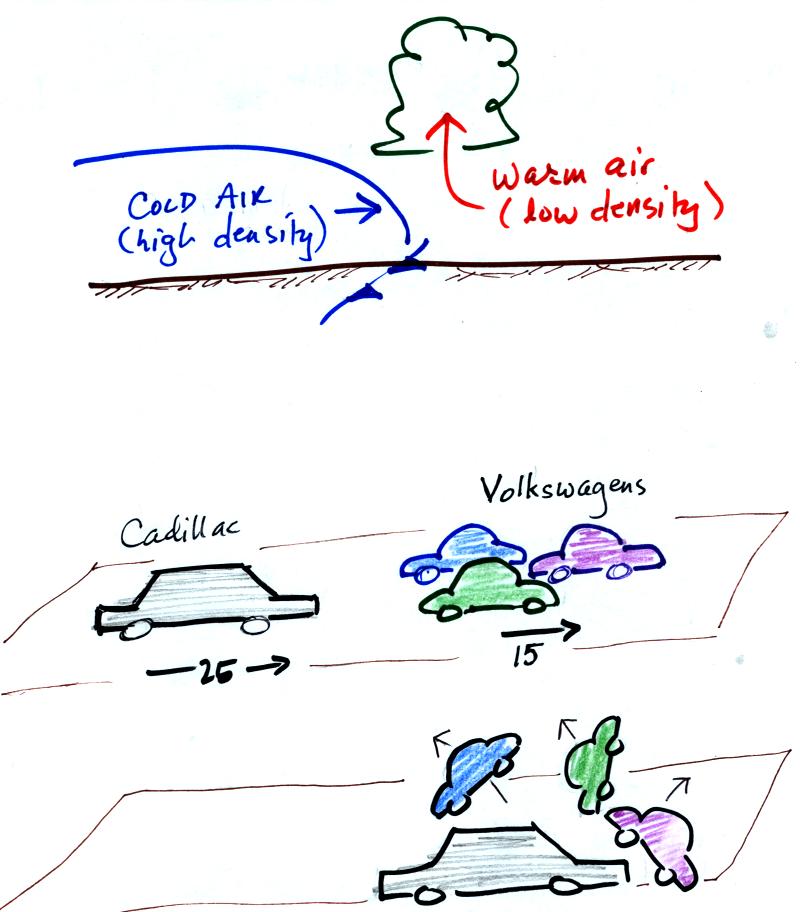
At the top of the figure, cold dense air on the left is advancing into warmer lower density air on the right. We are looking at the front edge of the cold air mass. The warm low density air is lifted out of the way by the cold air.
The lower figure shows an analogous situation, a big heavy Cadillac plowing into a bunch of Volkswagens. The VWs are thrown up into the air by the Cadillac.
Here's a crossectional view of a warm front, the structure is a little different.
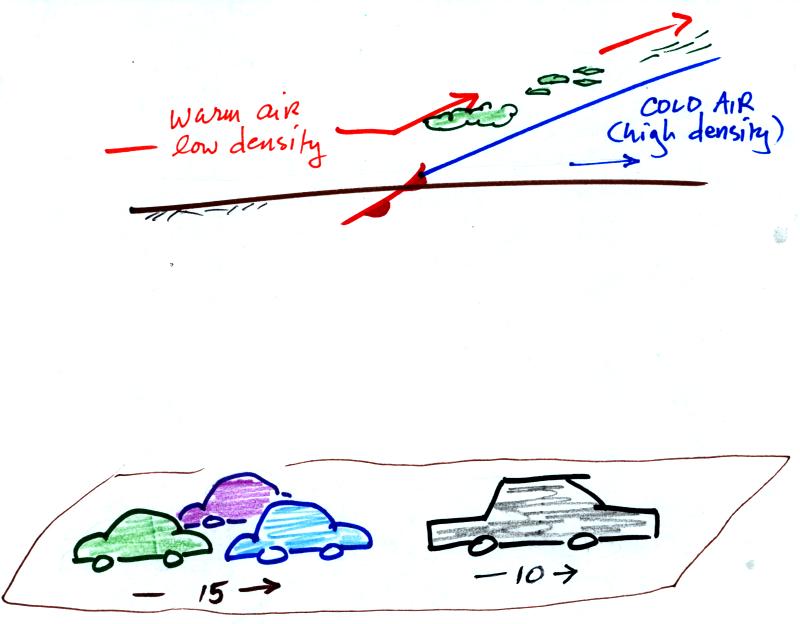
In the case of a warm front we are looking
at
the
back,
trailing edge of cold air (moving slowly to the right). Note the
ramp
like shape of the cold air mass. Warm air overtakes the cold
air. The warm air is still less dense than the cold air, it can't
wedge its way underneath the cold air. Rather the warm air
overruns the cold air. The warm air rises again (more gradually)
and clouds form. The clouds generally are spread out over a
larger area than with cold fronts.
In the automobile analogy, the VWs are catching a Cadillac. What happens when they overtake the Cadillac?

The Volkswagens
aren't heavy
enough to lift the
Cadillac.
They run up and over the Cadillac.
Fronts are another way of causing air to rise. Rising air cools and if the warm air is moist, clouds and precipitation can form.
Now we will return to the surface weather map we have been analyzing.

The weather data plotted on the map indicate clearly the presence of cold and a warm fronts (we learn later about some of the criteria used to located fronts). Now we can begin to understand what is causing the rain shower along the Gulf Coast (clouds caused by an approaching cold front) and the cloudy rainy weather in the Northeast (an approaching warm front and also perhaps some convergence into the low pressure center).
Here are the four questions (and answers) that were on the optional in class worksheet (meant to give you a little practice interpreting surface maps). This wasn't an assignment and shouldn't have been turned in at the end of class.
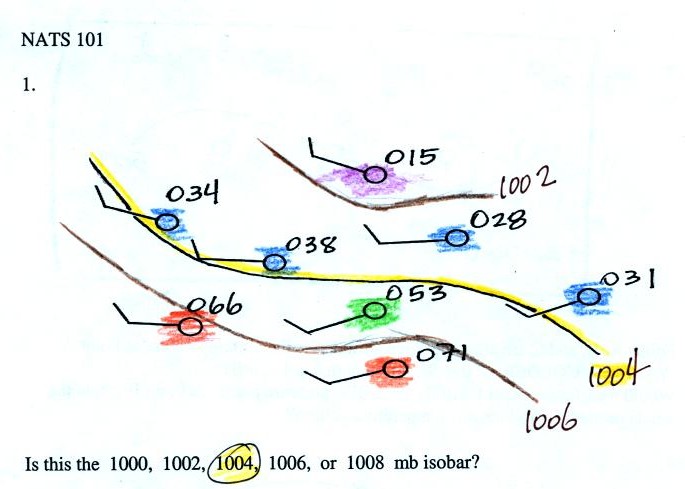
Now some new material.
The pressure pattern will also tell you something about where you might expect to find fast or slow winds. In this case we look for regions where the isobars are either closely spaced together or widely spaced. (I'm using some more carefully drawn pictures from the Spring 2008 class)

The winds around a high pressure center are shown above using both the station model notation and arrows. The winds are spinning clockwise and spiralling inward slightly.


The pressure pattern determines the wind direction and wind speed. Once the winds start to blow they can affect and change the temperature pattern. The figure below shows the temperature pattern you would expect to see if the wind wasn't blowing at all or if the wind was blowing straight from west to east. The bands of different temperature are aligned parallel to the lines of latitude. Temperature changes from south to north but not from west to east.



The converging winds in the case of low pressure will move the air masses of different temperature in toward the center of low pressure and cause them to collide with each other. The boundaries between these colliding air masses are called fronts. Fronts are a second way of causing rising air motions (rising air expands and cools, if the air is moist clouds can form)
Cold air is moving from north toward the south on the western side of the low. The leading edge of the advancing cold air mass is a cold front. Cold fronts are drawn in blue on weather maps. The small triangular symbols on the side of the front identify it as a cold front and show what direction it is moving. The fronts are like spokes on a wheel. The "spokes" will spin counterclockwise around the low pressure center (the axle).
A warm front (drawn in red with half circle symbols) is shown on the right hand side of the map at the advancing edge of warm air. It is also rotating counterclockwise around the Low.
Clouds can form along fronts (often in a fairly narrow band along a cold front and over a larger area ahead of a warm front). We need to look at the crossectional structure of warm and cold fronts to understand better why this is the case.
This type of storm system is referred to as an extratropical cyclone (extra tropical means outside the tropics, cyclone means winds spinning around low pressure) or a middle latitude storm. Large storms also form in the tropics, they're called tropical cyclones or more commonly hurricanes.
The top picture below shows a crossectional view of a cold front

At the top of the figure, cold dense air on the left is advancing into warmer lower density air on the right. We are looking at the front edge of the cold air mass. The warm low density air is lifted out of the way by the cold air.
The lower figure shows an analogous situation, a big heavy Cadillac plowing into a bunch of Volkswagens. The VWs are thrown up into the air by the Cadillac.
Here's a crossectional view of a warm front, the structure is a little different.

In the automobile analogy, the VWs are catching a Cadillac. What happens when they overtake the Cadillac?

Fronts are another way of causing air to rise. Rising air cools and if the warm air is moist, clouds and precipitation can form.
Now we will return to the surface weather map we have been analyzing.

The weather data plotted on the map indicate clearly the presence of cold and a warm fronts (we learn later about some of the criteria used to located fronts). Now we can begin to understand what is causing the rain shower along the Gulf Coast (clouds caused by an approaching cold front) and the cloudy rainy weather in the Northeast (an approaching warm front and also perhaps some convergence into the low pressure center).
Here are the four questions (and answers) that were on the optional in class worksheet (meant to give you a little practice interpreting surface maps). This wasn't an assignment and shouldn't have been turned in at the end of class.

